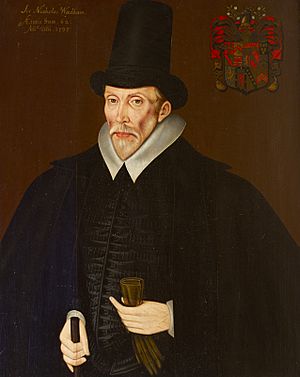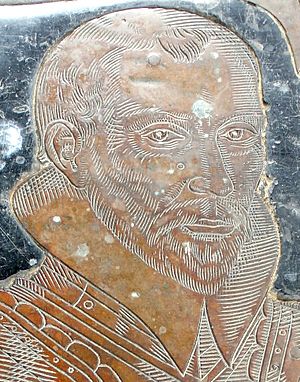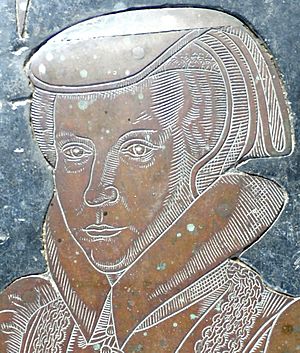Nicholas Wadham (1531–1609) facts for kids
Nicholas Wadham (born 1531, died 1609) was an important English gentleman. He lived at Merryfield in Somerset and Edge in Devon.
He is famous for helping to create Wadham College, Oxford, along with his wife Dorothy Wadham. She made sure the college was finished after he passed away. Nicholas Wadham also served as the Sheriff of Somerset in 1585.
Family History
Nicholas Wadham was likely born at Merryfield. This was a large, strong manor house with a moat, built around 1400. It was built by his ancestor, Sir John Wadham, who was a judge during the time of King Richard II.
Nicholas was the only son of John Wadham (died 1578). His father was also a Sheriff of Somerset and Dorset in 1556. His mother was Joan Tregarthin (died 1583).
His grandfather, Sir Nicholas Wadham (1472–1542), was also a very important person. He was a member of Parliament and a sheriff in several counties. He even went with King Henry VIII to a famous meeting called the Field of the Cloth of Gold in 1520.
His Life and Work
Nicholas Wadham went to Corpus Christi College, Oxford, but he did not finish his degree. He also spent some time working at the royal court. This means he was involved in the king's official business.
He took on many public duties in Somerset. He helped manage local affairs and was known for his kindness. Nicholas was also very generous and welcomed many guests to his home at Merryfield. People said his house was "an inn at all times, a court at Christmas." This means it was always open and busy with visitors.
Nicholas and his wife were sometimes suspected of not fully following the official Church of England. However, they were not punished for this. A writer named John Carpenter dedicated a book to Nicholas. He praised Nicholas for his "gentle friendliness with all persons" and his generosity.
Marriage and Family
On September 3, 1555, Nicholas Wadham married Dorothy Petre (born 1534/5, died 1618). She was the oldest daughter of Sir William Petre, who was a top secretary to King Henry VIII.
Nicholas and Dorothy did not have any children. They lived with Nicholas's parents until his father died in 1578. After that, his mother moved to another house.
His Death and Legacy
Nicholas Wadham died on October 20, 1609, when he was 77 years old. He was buried in the Wadham family chapel at the Church of St Mary, Ilminster. His tomb is still there today. It has beautiful brass carvings.
In his will, Nicholas left a large amount of money for his funeral. He also wanted to use much of his wealth to create something lasting. In 1606, he started an almshouse in Ilton. This was a place for eight poor people to live.
Nicholas had also been saving money to start a college at Oxford University. His plans were not fully written down when he died. However, his wife Dorothy made sure his wishes came true. She added a lot of her own money and, even though she was old, she oversaw the building of Wadham College, Oxford.
Even though much of his wealth went to the college, his sisters' families still received large inheritances. Today, the Wadham family's Merryfield estate is still owned by the Wyndham family, who are descendants of his sister Florence.





